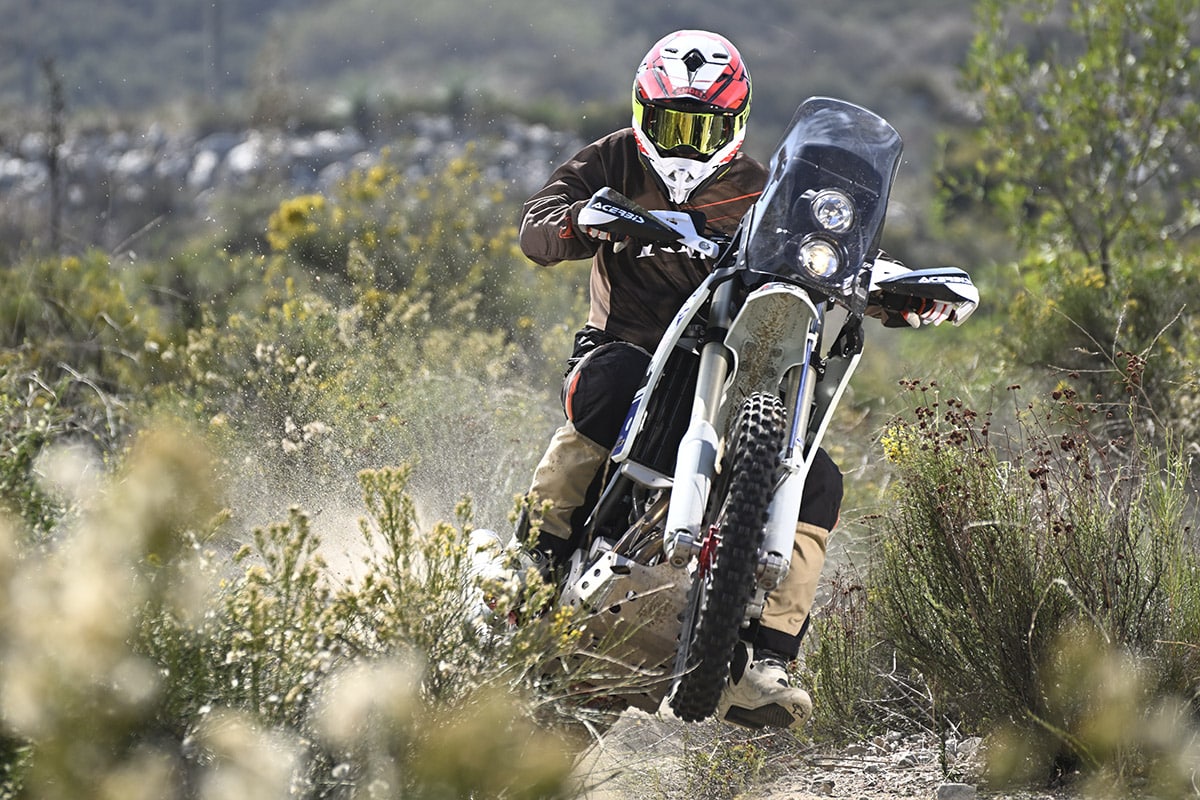Specialization has played a crucial role in shaping the landscape of the motorcycle world, creating distinctions between various categories such as enduro bikes and extreme enduro bikes, or motocross bikes and Supercross bikes.
The AJP PR7, however, takes the concept of specialization to unprecedented levels, belonging to a distinct category of American off-road bikes that lacks a definitive name for now. For the purpose of reference, we’ll temporarily label it a rally bike, even though such an activity is not widely recognized in the United States at this moment.
While the AJP PR7 may not be a familiar name among American riders, it traces its roots back to the original Husqvarna four-stroke from the 1980s.
Originating from Portugal, AJP is a relatively young company in the U.S., founded by Portuguese enduro champion Antonio J. Pinto, named after his initials.
Currently, the company focuses on producing chassis for its products, with motors sourced from various parts of the world. The flagship model, the PR7, utilizes an Italian-made SWM motor, a name that might not be widely known in the U.S. context.

Husqvarna, a company with a more recognizable history, plays a part in the PR7’s lineage. Those familiar with the days before Husqvarna’s ownership changes might recall the TE630, featuring one of the last motors designed by the Italian engineering team before their dismissal.
A closer inspection reveals echoes of design similarities dating back to the original Husqvarna 510 of the 1980s, an advanced off-road four-stroke in its time.
Presently, the PR7 boasts a 600cc, DOHC four-stroke engine with Athena/GET fuel injection, a hydraulic clutch, and a 6-speed gearbox. The frame design is unique, featuring a steel steering head attached to cast aluminum side beams
Notable components include a fuel tank positioned under the seat, Sachs suspension on both ends, and a striking-down swept titanium Doma exhaust system with a carbon fiber end cap. Brembo brakes, wraparound handguards, an aluminum skid plate, and a tablet for navigation are among the stock equipment, contributing to the bike’s overall appeal.
For riders who enjoy high-speed travel over expansive terrains, the PR7 presents an enticing option.
Determining an appropriate testing ground for a bike like the PR7 poses a challenge. In this case, the 24 Hours of Glen Helen provided an opportune setting. While the PR7 wasn’t officially entered in the race, it served as an ideal chase vehicle with its 4.5-gallon fuel capacity and ample storage for tools and parts.
Addressing the elephant in the room, the PR7’s weight exceeds 400 pounds with a full tank, making it a substantial machine. However, its narrow profile, comparable to a typical 450 motocross bike, and relatively low seat height may initially deceive observers.
Riding it reveals a preference for higher speeds, with its mass becoming more evident at lower speeds. The bike truly shines when pushed to higher velocities, showcasing its impressive power, especially in the low-end torque.
The 600cc engine delivers a unique blend of power reminiscent of older four-strokes with a smooth, robust torque curve. Unlike its predecessors, the AJP PR7 maintains cleanliness and civility in its performance, devoid of coughing, backfiring, or flameouts.
Despite the bike’s weight, finding open spaces to fully unleash the PR7’s potential proves to be a rewarding experience. The motorcycle can effortlessly accelerate even at high speeds, providing a thrilling ride.
The challenge lies in the bike’s suitability for truly rough terrains. While equipped with top-notch Sachs suspension, the PR7’s rear suspension is deemed too soft for extremely challenging conditions.
Whether adjustments can sufficiently address this issue remains uncertain, particularly given the unique characteristics of a 400-pound bike.
The tablet mounted behind the windscreen serves as the primary instrument, syncing with smartphones for navigation.
The potential for the PR7 as a rally bike becomes more evident if the sport gains traction in the U.S. A beautifully crafted motorcycle with high-quality components, and the PR7 may currently find its niche as an outlaw dual-sport bike.
In certain states, obtaining a license plate for the PR7 is feasible, making it a versatile option for riders. AJP’s U.S. importer, Central Powersports Distributing, is in the process of homologation, and the PR7’s motor has successfully passed emission testing in previous incarnations.
This positions the PR7 to potentially dominate the specialized category of non-street-legal big-bore rally bikes in the U.S., pending the adoption of a more fitting name for this unique class.

